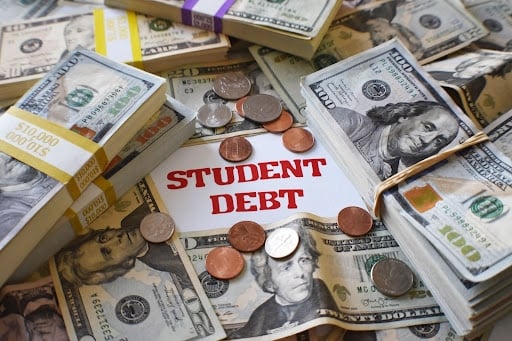You have /5 articles left.
Sign up for a free account or log in.

Darren414/Getty Images
President Biden has hinted that he is considering relieving at least some of the $1.7 trillion in debt owed to the federal government by more than 40 million student loan borrowers. However, with the final proposal still up in the air, the feasibility of that approach has been questioned by both Department of Education officials and higher education experts.
Concerns have also been raised about the long-term implications of debt relief, including the need to reform the country’s highly complex student loan and servicing programs and system.
“It seems increasingly apparent that the Biden administration intends to announce some sort of loan cancellation or forgiveness effort, but there is absolutely no information available to help people understand even the most basic elements of what such a policy would look like,” said Terry Hartle, senior vice president of the American Council on Education. “There’s a great deal of confusion and uncertainty about what might happen.”
With the current pause on student loan payments expiring in September, weeks before the midterm elections, the Biden administration has yet to make a move on one of its central campaign promises: to relieve at least $10,000 in student debt per borrower. Facing mounting political pressure from fellow Democrats and voters, Biden has indicated that he is likely to announce some sort of forgiveness plan in the coming weeks.
Student debt forgiveness has since become highly politicized, with Democrats arguing that relief is a necessary move for post-pandemic economic recovery and Republicans, on the other hand, arguing that forgiveness is a wasteful use of federal resources that will give an unfair benefit to the wealthy and hurt the working class.
What Biden Has Done So Far
According to the Department of Education, since last January the Biden administration has forgiven around $18.5 billion in student loan debt to more than 750,000 borrowers through programs including the Public Student Loan Forgiveness program, student debt forgiveness for those with total and permanent disabilities, and forgiveness for students who attended the now shuttered for-profit ITT Technical Institutes.
The pandemic-era pause on student loan payments, with a 0 percent accrual of interest, has been extended four times since Biden took office. This move has provided temporary relief to borrowers with federal debts throughout the COVID-19 pandemic. The pause is set to expire on Aug. 31.
Additionally, changes that expanded qualification for the 2007 PSLF program under the Biden administration helped grant forgiveness to more than 100,000 borrowers, according to data from the Department of Education. This policy allows some borrowers working in nonprofit and government jobs to have their federal debt erased after 10 years in service or 120 monthly payments.
The administration also made changes to the income-driven repayment plan and Pay As You Earn to allow some borrowers to qualify for forgiveness after 20 to 25 years of payment. These programs both use an income-based formula to make student loan payments more manageable and affordable. The Education Department estimated this plan would automatically forgive debt for at least 40,000 borrowers.
Income Caps?
As the payment pause end date looms closer, progressive Democrats, including Senators Chuck Schumer of New York, Elizabeth Warren of Massachusetts and Raphael Warnock of Georgia, want Biden to use his executive authority to erase at least $50,000 of debt per borrower. However, the administration has stated that this figure is likely off the table, and reporting from The Washington Post has indicated that the administration is considering implementing forgiveness with an income cap that could exclude borrowers who earn more than $125,000 to $150,000 a year.
According to Politico, multiple Education Department officials said that means-tested forgiveness could pose several challenges because of the department’s lack of access to income data needed to provide automatic forgiveness. Annual income data are collected by the Internal Revenue Service through tax information. The Education Department does not have access to this information under current law.
As a result, an income-driven approach would likely require an application process, where borrowers would provide proof of income. Both the department and higher education experts have expressed concerns that this approach could create a confusing bureaucratic system for borrowers.
Braxton Brewington, press secretary of the Debt Collective, an organization representing debtors, said low-income borrowers could be disproportionately excluded from means-tested programs because they are less likely than wealthier individuals to file their taxes.
“Creating paperwork is just simply going to be a disaster for those—specifically, it’s going to be the biggest disaster for low-income people,” said Brewington. “The irony [of] means testing and cancellation and application programs is that the people you’re supposedly targeting will be excluded.”
Brewington said that automatic relief without an income limit would allow more borrowers to take advantage of forgiveness without bureaucratic barriers.
Additionally, lack of communication between borrowers and the Department of Education has led to confusion on what borrowers currently qualify under existing forgiveness plans, which experts say will likely be exacerbated under forgiveness expansion.
A report released by the U.S. Government Accountability Office) in March found that 11 percent of those who qualified for loan forgiveness under the income-driven repayment plan had not yet applied. According to the report, the Education Department cited data limitations and lack of communication with borrowers as the main source of difficulty identifying qualifying borrowers.
According to a January study by the Education Data Initiative, only 6.7 percent of eligible student borrowers apply for loan forgiveness.
Multiple experts said that the lack of communication between the Department of Education and student loan providers has been long-standing. Scott Buchanan, executive director of the Student Loan Servicing Center, which represents both public and private student loan providers, cited that lack of guidance to providers from the Department of Education, which he said has made it difficult for loan-servicing centers to connect borrowers with the relief they might be entitled to in the face of a complex borrowing system.
“It’s going to be really complicated to do this. Anyone who says anything that’s easy in this program hasn’t been around for a minute. It is incredibly complicated to deliver any of these benefits,” said Buchanan. “Especially when you do these kinds of big programmatic changes and you don’t have any time to plan for it but try to do it quickly, you’re gonna screw it up.”
Concerns have also been raised about the Department of Education’s ability to handle an influx of paperwork if an application process is necessary for loan forgiveness. According to Politico, the Education Department has already struggled to service borrowers during the federal loan repayment freeze due to cuts to staffing.
“The Department of Education is the largest consumer bank in the country. The problem is that they have not been staffed like a bank,” said Buchanan.
A Department of Education spokesperson told Inside Higher Ed, “The department’s review of broad-based debt cancellation remains ongoing.”
The Need for Reform
Many higher education officials said although forgiveness would provide temporary relief to borrowers, broad reforms are needed to simplify student loan programs and fix administrative issues to increase transparency between borrowers, the Education Department and loan servicers.
“Absent from the conversation is anything to do with how we are going to reform the system so we’re not back in this exact same position in one year, five years or 10 years,” said Justin Draeger, president and CEO of the National Association of Student Financial Aid Administrators. “Forgiveness without student loan reform would be a pretty big mistake.”
“I think that sort of targeted relief is needed sooner rather than later, but if we’re looking at across-the-board debt forgiveness, to do so without putting forward a comprehensive set of solutions on student loan reform strikes me as politically expedient but pound-foolish,” he continued.
Reforms cited include making student loan repayment easier to navigate so borrowers can better decide which plan is best for them.




